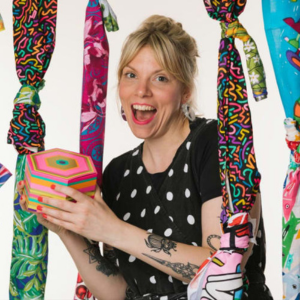Wearing Art
By Ruby O'Connor
We may not necessarily notice but every time we accessorise ourselves we are wearing somebody’s craft, their hard work, their art. But these artworks don’t always have to be worn to be appreciated. When we think of jewellery, we think of gold, silver, divine stones all the elemental and organic materials. Now pieces are constructed with pretty much anything and can look like anything but jewellery. In our modern world, both jewellery and art can be whatever we want them to be; find out more in Wearing Art
Even from the earliest times, jewellery was worn as a status symbol, rank or even a form of protection. Some of the earliest found jewellery can be traced back to Mediterranean civilisations around 3,000 to 400 BCE.
The natural world always an inspiration; in East Asian cultures around the last centuries of the second millennium, bone and ivory hairpins carved into birds or abstract figures were popular.
African cultures used more elemental materials such as silver, using embossing, and coin and stone insertion techniques to form pieces such as bracelets, necklaces, rings, belt buckles, earrings and brooches.
Embellishments of the middle ages across Europe continued to be extremely hierarchical and status-driven. Often royalty alongside nobility wore silver, gold and prized gems, with the other half of society wore copper or pewter which class as various alloys.
Over time like everything, this art form evolved. The Art Nouveau style movement (1895-1920) caused a powerful shift in the design of jewellery, peaking around 1900 when it came out on top at the Paris international exhibition which was a world’s fair held in Paris, France. This infamous fair was to celebrate the achievements of the past century and therefore stimulate development into the next.
These new styles of adornments had undercurrents of eroticism and death, which were worlds away from the floral and natural-world themes of former adornments. Jewellers additionally distanced themselves from the typical precious stones and focused on the subtle effects that worn, glass and enamel exude.
Another era was Arts Décoratifs, (Art Deco) jewellery design between the 1920s and 1950s continued to be glamorous and innovative. Exotic inspirations came from the Near and Far East while geometric and sharp patterns lionized the machine age. One of the main characteristics of Art Deco jewellery was dense concentrations of gemstones
It took all this history which is nearly as old as man to get to where we stand now, when any material any shape and style can be worn, or maybe not just worn but see as a work of art alongside something to wear
Currently, there are two exhibitions at The Design Museum at the Pinakothek der Moderne in Munich, Germany, featuring contemporary art jewellery from Therese Hilbert and the current students and past graduates of the jewellery and fashion department at Bezel Academy Jerusalem.
These instalments are on display until the 30th of July and are helping to promote the journey of jewellery into the art world.

Moran Cohen. Necklace “Random Symmetry”, 2014. Copper, enamel, decals. Photographer: Liat Elbling
The Bezel Academy of Arts and Design is recognised as Israel’s finest educational centre for architecture, art and design. The exhibition itself is named SAGSOGET. ALLOY. LEGIERUNG Part of the title derives from the word alloy = fusion, fusion in Hebrew = sagsoget and it seeks to reflect the spirit of recent jewellery creations at Bezel.

Carmel Goldental. Rings “Holding a memory”, 2016. Silver. Photographer: Liat Elbling
The creators of these marvellous pieces come from all over Israel – from different religions, sectors, and ethnicities. They showcase the pure talent and skill of the artists studying at Bezel. The pieces consist of varying textures, materials, sizes and shapes.

Itai Shiftan. Brooch, 2022. Stainless steel, aluminum. Photographer: Liat Elbling
The second exhibition is titled RED which features art by a singular Swiss jewellery artist Therese Hilbert presenting around 250 pieces of her life’s work, beginning with practically unchartered early works all the way through to her up-to-date works created in 2020.
The Swiss jewellery artist has many awards under her belt such as the Herbert Hofmann Prize, which is regarded as the ‘Oscars of Jewellery’, and the Bavarian State Prize which is awarded to the best graduates of vocational schools every year.

Brooch, 1996, silver blakened, coral, h. 3,0 cm, Ø 6,9 cm, Die Neue Sammlung – The Design Museum. Permanent Loan from the Danner Foundation, Munich, Germany (photo: O. Künzli)
Hilbert strives for absolute perfection in her work, conveying calm and strength, not the be confused with coldness and distance, often associated with metal pieces. Using silver rather than gold, her formal glossary stems from the classical canon of basic shapes, surrounding discs with frames thought to protect them.

Brooch “Aus der Tiefe (Out of the Depth)“, 2017, silver blakened, laquer, h. 3,7 cm, Ø 6,6 cm, private collection (photo: O. Künzli)
She plays with the component exchange between the silver and the ambient light by brushing it to create a matt surface, adding delicately drawn hatching, oxidizing or whitening her works.
Jewellery is art, in as much as how anyone views art, art of course is in the eye of the beholder.
If you enjoyed reading Wearing contemporary art, why not try I Only Have Eyes for YOU.
.Cent London, Be inspired; Get involved





